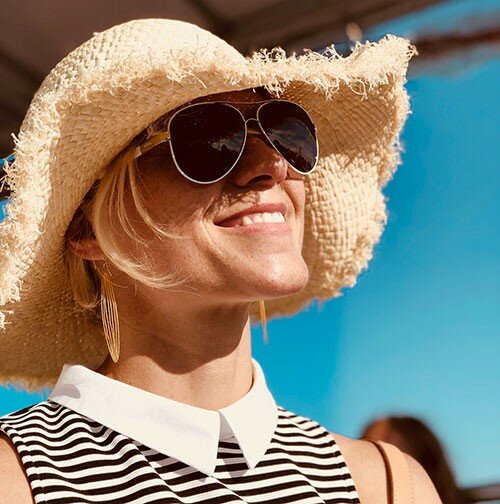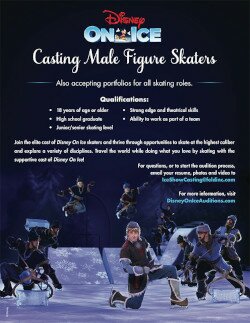

Photo: Bohdan Turok
Tired of the long, harsh winters, Shae-Lynn Bourne, a 10-time Canadian and the 2003 World ice dance champion, headed south in early 2019 to ply her craft in warmer climes. The world-renowned choreographer, who produced the long program that Yuzuru Hanyu performed to win the 2018 Olympic title, and a trio of short programs over as many years for two-time World champion Nathan Chen, left her South Carolina base last December and moved to Southern California. It was, she said, the right move at the right time for herself and her family.
While much of North America remained in lockdown mode through the early spring months to help contain the spread of the COVID-19 pandemic, Shae-Lynn Bourne remained steadfast in her desire to keep producing new programs for her skating clients. With arena doors near her Laguna Beach home shut tight, and international travel at a halt, Bourne’s creative juices kicked into gear.
Without missing a beat, she turned the garage in the home she shares with her husband, Bohdan Turok, and their son, Kai, into a makeshift studio. And with technology such as Zoom and FaceTime available, Bourne and the skaters she is working with have been brought into the same room — and magical collaborations have begun to unfold.
“I’ve gotten into choreography in a new way,” the 44-year-old said during a conversation with IFS in mid-May. “I have kind of made the garage into my ice rink, so I’ve been doing some choreography online. It has been wonderful to have that chance, just because the movement gives me that feeling of being on the ice.”
Instead of ice, Bourne has mats laid out on the floor of the garage, along with a computer and an iPhone with music playing out of one of them. “It is my happy place. I will go upstairs (after a session) and definitely, I am just happier,” she said. “I’ve had that hour or two hours, and that has been great.
“I just make it so the whole room is visible. The skaters can see my movements, do the same as I am doing, whatever space they are in — and I can see their movements. It works. There is not much difference. It’s just copying what the other person is doing and taking time to talk about the story, the patterns, and the setups for jumps.
“When the time comes and travel can happen we will get back on the ice. But until then, I’ll do as much as I can with them. For some skaters, they may get back on the ice sooner in their country, so if that happens, we can probably set up cameras and I will be able to be there, just not physically. I just have to be more creative to make it work.”
Creativity, as anyone who knows her will tell you, absolutely oozes from Bourne, who has become one of the skating world’s most in-demand choreographers. Her client list starts with reigning and two-time Olympic champion Yuzuru Hanyu of Japan and two-time World champion Nathan Chen of the United States.
Among the many skaters that have felt the Bourne touch within the last year are Mariah Bell of the U.S. and Canada’s Stephen Gogolev who, along with Chen, train in nearby Irvine, California; Japan’s Rika Kihira, Wakaba Higuchi and Shoma Uno; South Korea’s Young You and Jun-Hwan Cha; Evgenia Medvedeva of Russia, and Matteo Rizzo of Italy.
Indeed, if all had been normal with the world, Bourne planned to spend time in Japan and Korea in May working on new programs with some of her clients, while others were to be done in California.
Not that it would be difficult to convince skaters to make the trip to her rather idyllic setting. “When you are going off to do choreography, it is nice to have a change of atmosphere,” said Bourne who lives just a 7-minute walk from the Pacific Ocean. “Every day, when you see the ocean, it just resets you in a positive way and it does that for the skaters, too. It is a change from their everyday training site, and it just gives them a new experience — a happy one. People don’t mind coming here.”
In March, Bourne spent a week with Medvedeva in California, working on a new long program for next season. “That was sort of the start of the new round of programs,” said Bourne. “I had people lined up week after week from that point, going back to even before Worlds.”
But then, the reach of the coronavirus began to hit North America with full force. Sports events across the continent were shut down, and the 2020 World Championships in Montréal were cancelled. Skating was put on ice, so to speak, though there were hopeful signs at the end of May with training resuming in some countries.
Like many in the sport, Bourne admitted she was “sad and disappointed” to see the 2019-2020 season end so abruptly, without World champions being crowned. While she planned to be home in California that week working on choreography, she said she “would certainly have been watching and following the event closely.”
But she also knows that, in the end, the right decision was made. “The thing is, cancelling the event was for a much greater reason and I think everyone will say the same thing. That kind of takes over and the priority of everyone’s health is way beyond holding any event. “I felt for the skaters because I know how hard they worked, and it takes a whole year to prepare for this one big event. I am sure they were all in top shape and they were ready.
“Skating is our passion, but life and the health and safety of everyone has to come first. Even now, it is an unusual time. We are so used to connecting and being social — I think we are naturally designed that way. This new way of me staying away from you is helping you. It is a bizarre thought but it’s important right now, it really is.”
Bourne can already imagine a new reality when skaters do return to the ice, but one that does not diminish the passion she or anyone else has for the sport. “I do think, most likely, it will mean wearing masks and keeping distance from the skaters,” she said when asked how her role might change. “But it is a big ice surface and we can still see each other from farther apart. If it means doing that, then that is the way it has to be … if we can do what we love within that, we’ll work with some new boundaries.”
THE PACIFIC CALLS
Bourne and Turok could not have imagined the current state of the world when they made the decision a year ago to leave Toronto and relocate to Charleston, South Carolina. Though she is Canadian through and through, Bourne admits having no fondness for the country’s harsh winters — especially given that her job already involves spending many hours in cold ice rinks. It is why she kept a vacation home on Pawleys Island, South Carolina, for many years.
“That was the beginning of me wanting to find a warmer place,” Bourne said of the “little house” she bought in 2006. “I just took a flight to Myrtle Beach and drove around until I found what I wanted. I always kept that place and kept going back to it.”
When she and Turok married in 2011, it was the place they chose to spend their honeymoon. But they found something even better one day when they took a 90-minute drive down the Atlantic Coast to historic Charleston. “We both just fell in love with it and made the decision then that we would come back to this place,” said Bourne. “So, we sold the place on Pawleys and got a condo in Charleston. I had been doing choreography there for three years, so we would go there in the summer. We loved it. Eventually, we thought ‘why not make it home?’ You know, take the next step. We wanted to try something new, and it was a very different experience and way of life. We were really content, and we met so many great people there.”
Bourne had also found a welcoming home for her talents at the Carolina Ice Palace, a two-pad facility located in North Charleston. But skaters who came to work with her got much more than just choreography sessions on the ice. “They also got a great experience because there is so much history there,” Bourne said. “Whenever a skater would come in for a week, we always took them out to dinner downtown so they could really experience some world history and they would have something more to say when they got on the ice. It is a hidden treasure and well worth the journey. It’s quaint and beautiful.”
But Charleston also had its limits. While the city has its own airport, getting there is not easy and requires a connection through larger airports in neighboring states such as North Carolina or Georgia. But as happy as they were in Charleston, there was always the pull of California in the back of their minds. It would mean more opportunities for Bourne and Turok, whose career is in filmmaking. And so it was that Laguna Beach became their new home last December.
“My husband had finished writing his first feature screenplay (which is set to go into production in March 2021, with Turok directing it), and that was sort of the driving force for us to say, ‘we’ve always talked about California, now is the time to do it,’” Bourne recalled. “It is just like skating, and I think of it that way. If you want to be at the top, you have to be in the right place. You have to be in the right environment with the right coach. That was the big push and it was good for all of us.”
For Bourne, it has widened the scope of available workplaces to ply her craft. While she spends most of her time at the Great Park Ice & FivePoint Arena in Irvine — home base for coach Rafael Arutyunyan and his elite group — ice is also plentiful at rinks in other nearby places such as Anaheim and Lakewood. The Irvine facility is a mere 20-minute drive from Bourne’s residence.
“Rafael has been very welcoming to me,” said Bourne. “In December, I started doing group classes for his other skaters. It has really been nice to be in that environment, with both the competitive group and the people who just love to skate. I get to share my knowledge with them. It’s not just the choreography, but working on skills, creativity, the artistry … it has been really wonderful. And then I can go to other nearby rinks like in Anaheim, where I can get private ice and be one-on-one with a skater. There are quite a few to choose from where I can get early morning ice, so it’s been a good fit.”
Bourne said that good fit also applies to her son, a creative soul who celebrated his eighth birthday in June. Kai has been doing online classes since March, when the pandemic shut down his school, which has turned his parents into teachers as well. “That is a new position for us to be in, but we’ve all settled in to that adjustment,” she said.
But the learning does not end there, and Bourne speaks proudly of the comic books that Kai has been creating. “He actually connected with a friend through Zoom and they started a comic book of Batman and Spider-Man versus COVID-19. It’s amazing — they want to destroy it,” she said. “They don’t like the way life is right now, they want to hang with their friends. So it is their way of creating; they are writing their own thing. It is great because good things can come out of this. We are encouraging Kai to work hard and learn, and he can learn a lot during this time at home.”
GETTING CREATIVE
The biggest question being asked — at least in the skating world — is when does the sport emerge from its current deep freeze? It is a query that has obviously crossed Bourne’s mind, given what she does for a living. But she admits it is not something she allows herself to spend too much time thinking about — at least not yet.
“Nobody can even guess right now how things will be, so I can’t even go there,” she replied when asked about her level of optimism for the season ahead. “Otherwise, my mind goes in so many different ways … ‘well this could happen, or that could happen.’ All we can do is keep creating and keep doing what fulfills us and stay connected.
“It is important to stay connected to the skaters because they want to keep their passion alive and they can use this time to grow, to understand their bodies better, to become stronger and to understand their voices better. So, when they do get back on the ice, they can really share what they want to express to the world. That’s important to me, just carrying on and being ready for when we do start again.”
What also has to be considered is what competitions will look like when they resume, given the new priority on safety and the precautions necessary to ensure that. Testing for COVID-19 will surely be a part of that new reality, along with the continuance of physical distancing. But what if it is mandated that competitions can only happen with no spectators in the building? This is a sport that, after all, relies heavily on an intrinsic connection between the performer and the audience. Can it be the same without that?
Bourne prefers to see it from a more uplifting perspective, one where the connection will still exist — just in a different way. “It will definitely change a performance. It can’t be exactly what it was if you do not have a full audience,” she said. “Even now, when people are doing any sort of online class or performance, they don’t have that actual audience, but there is a knowing (that it is there). We have our obvious senses … without seeing, or without hearing the people around you, the feeling that you know they are there.
“If you know and you are aware there are these people who can see you, whether it is in person or at a distance, there is a different kind of connection that you have. Maybe that will help skaters to feel connected in a new way, that how they perform has to go beyond just the reach — it has to come from within with a real presence. That is the type of performance that, whether you are there or you are watching it on YouTube, you feel that performance and you are affected by it.
“It will definitely test the skaters and it will be an interesting challenge. I don’t think you lose your audience — they will just be watching it in a different way, and I am sure they will be craving it. If someone is a real fan of the sport and it is possible to see it in any way, they are going to watch it.”
Before the Québec government cancelled the World Championships, there had been suggestions that perhaps the competition could be held safely in an empty building. While some skaters might not have wanted to perform in that environment, Bourne wonders if that is a sentiment that might have changed since then. “I bet if you asked them now, they would say ‘we’ll do it.’ Because with all the time that passes not being on the ice … you cannot depend on that. It would be sad, of course (to compete in empty buildings), and it won’t be the same. But if you know you are keeping people safe and you are still able to do what you want to do, how lucky are you? How lucky are we? It is a new way and we have to be creative in how we approach things.”
Also falling into that ‘new’ category was “Open Ice,” an online show with skaters from around the world contributing their time to raise funds for the United Nations Foundation’s COVID-19 Response Fund. Former Canadian ice dancer Kaitlyn Weaver — who counts Bourne as one of her former coaches and her idol — came up with the idea, and turned to Turok for help with some of the behind-the-scenes logistics for the event, which lasted more than four hours and raised about $58,000.
The credit for the name of the show goes to Bourne, who came up with it while listening in as Weaver and Turok were working through their creative process. “I am so happy that the name worked, and it was fitting,” said Bourne. “It was the skating world and it was a very open thing. Kaitlyn brought us into everyone’s homes and also into her own home, and people were being very open about sharing their experiences. It was funny — it kind of got into a lot of emotions.
As for Bourne, one of the last to appear on the show, it was obvious the experience was a very emotional and an overwhelming one for her — but in a good way. “I felt more connected to everyone than ever before,” she explained. “When you are at an event, you kind of cross paths with people but it is so quick. You are in and out and it is never long enough to really get deep. When you get a more intimate one-on-one, it is more meaningful and it sort of felt that way listening to everyone. I felt that.
“And this time has been so emotional because on one hand, it has felt positive to live this way, but it is also heart-breaking because although it hasn’t affected me, it has affected other people in a different way. Someone has lost someone. Even Mike Marinaro who talked about losing his grandmother. It’s affecting everyone. It is devastating — it is absolutely devastating. I was feeling all those emotions and I said to Kaitlyn, ‘I feel like I’ve been on a rollercoaster.’
“I seriously do wake up every day feeling gratitude because I am OK and my family is OK. I just feel more appreciative and grateful for every moment.“
(This article was originally published in the IFS August 2020 issue)




